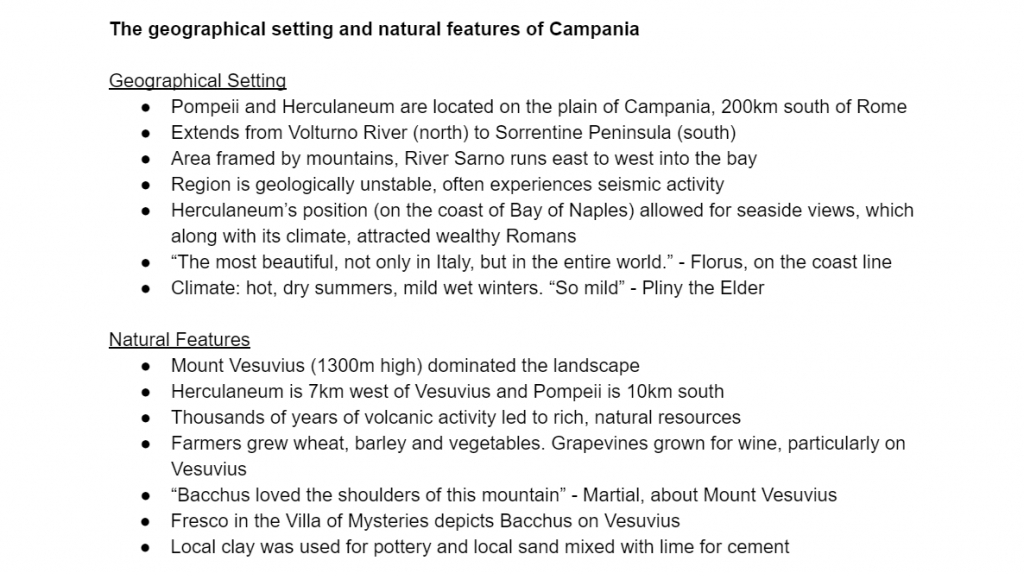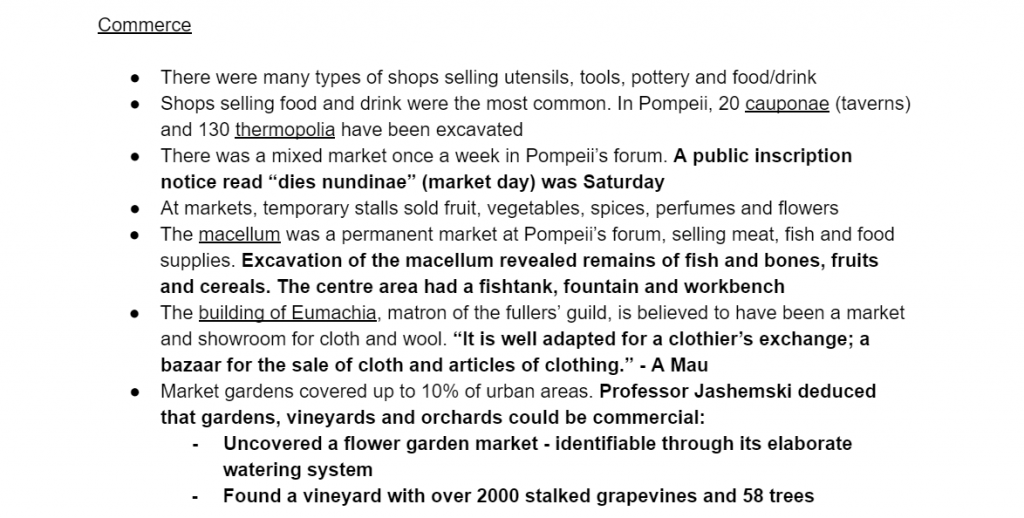Have you ever been overwhelmed at the prospect of writing HSC Ancient History Notes?
Maybe you’ve thought, “how can I possibly tackle THIS much information? Where do I even start?”
Well, have no fear! This guide will take you through a simple, step-by-step formula for creating an excellent set of personalised and well-rounded HSC Ancient History Notes that will help you smash your assessments and exams.
Step 1: Structure Your HSC Ancient History Notes
Step 2: Add Sources to your HSC Ancient History Notes
Step 3: Make Them Personal
Step 4: Update Regularly
Step 1: Structure Your HSC Ancient History Notes
One of the most common difficulties students have with creating notes is figuring out a smart and effective way to structure the notes.
When we interviewed a variety of high-achieving HSC Ancient History students we discovered that the most efficient and easy-to-understand method of structuring notes was to base them strictly around the syllabus.
Using the HSC Ancient History Syllabus
So, we’ve said that the best way to structure your notes is by basing them around the HSC syllabus, but what exactly does that look like?
Well, here is the syllabus for Pompeii and Herculaneum:
Remember, both the survey and focus of study are examinable, so you want address both of these in your notes.
And here’s an example of how to structure your notes around the syllabus, which in this case is: The geographical setting and natural features of Campania.
The headings and subheadings here are based, word for word, on the syllabus dot-points to allow for ease of use and improved memory retention.
But still you might be asking: How do I structure my notes based off syllabus headings if there are multiple things to cover in a single dot-point?
Well, we’ve got you covered for that too.
Breaking Up the HSC Ancient History Syllabus Dot-points
Let’s use another dot point as an example: religion: household gods, temples, foreign cults and religions, tombs.
A great way to simplify the structure of your notes when dealing with large dot-points like this one is to break it down into simple ideas that can be elaborated on individually.
For this example, you would separate your notes into four sections based on the headings: household gods, temples, foreign cults and religions, and tombs. As in the syllabus, these would all come under the heading Religion in your notes.
This keeps the individual aspects of each dot-point visually distinguishable and therefore make them easier to memorise and understand in context with the other aspects of the syllabus.
You can also learn how to write effective notes for HSC Modern History.
Step 2: Add Sources to your HSC Ancient History Notes
Ancient History is a subject that’s founded on sources. Without archaeology and the writings of modern and classical historians, we would have none of the information that we learn about in the HSC.
NESA recognises this, emphasised by the fact that they deem the inclusion of sources mandatory for any Band 6 response. As such, it is vitally important to include sources in your HSC Ancient History notes to increase your source vocabulary and, as a result, increase the quality of your exam responses.
In your notes you should aim to include a variety of types of archaeological sources, such as buildings, inscriptions, physical remains and other artefacts, as well as references to the work of modern historians.
Here is an example of how you can incorporate sources into your notes, using the dot point economy: commerce as an example.
Here, the information regarding commerce is supported with quotes and interpretations from historians, as well as archaeological sources (indicated by bold text and underlined text).
However, you don’t want to overload your notes with too many sources.
The key to a great set of notes is finding a balance between source and information. Need personalised feedback? Check out how our HSC tutors in Fairfield can help you get organised!
As a general rule of thumb, aim for 2-5 sources (of varying types) for each ‘idea’ or subheading, depending on how much information each subheading covers.
For example, under the subheading women under social structure, you might like to include three sources. These three could be: buildings such as the House of Julia Felix, written sources such as graffiti, and paintings in homes and brothels. This gives a variety of types of sources, which can be adapted.
If you include too many sources, especially for small ideas or subheadings like that one, you’ll soon find yourself overwhelmed with a set of notes that are way too large to be able to use effectively, regardless of how detailed they are.
Step 3: Make Them Personal
One of the reasons that writing your own notes is a necessity is because everyone writes notes differently. What does that mean?
- Some like to structure their information:
- In dot-points (the most common structure)
- In short paragraphs
- In long expositions
- Some like to include sources:
- As simple dot-points
- As part of a table
- Some like to define tricky ancient terms:
- In the sentence they use them (e.g. “Most houses have lararia – small shrines dedicated to the lares“)
- In a separate glossary
- Some like to write in:
- Long, full sentences (e.g. “Tombs were constructed outside the city walls, along the busiest streets, and near the gates.”)
- Short, truncated sentences (e.g. “Tombs were outside city walls, along busy streets, near gates.”)
Discovering your own personal style of note-taking is part of the process and will occur naturally through trial-and-error.
Maybe you want to include the definition of terms wherever they’re mentioned, or maybe you don’t want to define them at all in order to save space (if you already know what they mean).
Don’t write your notes for anyone else except you.
If you want to shorten sentences in a way that only you will understand, do it.
As long as it makes it easier for you to read and memorise later on, personalising your notes is a great way of learning the content.
Whatever you think might help you remember the information in your notes better, do it!
Not sure what type of learner you are and how to structure your notes? Check out this handy guide!
Step 4: Update Regularly
As you move throughout the year, be sure to keep your HSC Ancient History notes updated with any new information you learn.
A great way to do this is to follow along with the schedule that your class follows.
Struggling to keep up in class? Here are 4 HSC Classroom Habits you should be using!
For example, if you’re just starting Greece, make sure the notes for your last topic are up to date before you move on. If you’re halfway through Pompeii and Herculaneum, try your best to update your notes alongside the dot-point you’re learning about.
If you’re writing your notes at a time when you’ve already studied a particular topic, then try to review the materials and information you were given for that topic and complete a set of notes for it before you get too deep into the next topic.
Another great way to keep your notes updated is to collect any resources from school/library/online and cross-reference them with your information to ensure that your notes are correct and aren’t missing any vital information.
For more tips, take a look at this article on how to keep your notes up to date!
And that’s it! As long as you follow these steps, you should be well on your way to creating a fantastic personalised set of Ancient History notes that will help you smash the HSC!
On the hunt for other HSC Ancient History resources?
Check out our other resources so you can ace your final exam below:
- HSC Ancient History: The Ultimate Guide to a Band 6
- The Master List of HSC Ancient History Past Papers
- The Comprehensive 7 Day HSC Ancient History Study Plan
- How to Memorise HSC Ancient History Sources
Trying to improve your study notes for other subjects?
We’ve got guides for a range of subjects, which you can check out below:
- Standard & Advanced English
- Standard Maths
- Advanced Maths
- Modern History
- Biology
- Chemistry
- Legal Studies
- Economics
- Visual Arts
- PDHPE
Looking for extra help with your HSC Ancient History Notes?
We pride ourselves on our inspirational HSC Ancient History coaches and mentors!
We offer tutoring and mentoring for Years K-12 in a variety of subjects, with personalised lessons conducted one-on-one in your home or at one of our state of the art campuses in Hornsby or the Hills! For tailored support, contact our Hills District tutoring team, or our Parramatta tutoring team!
Get help writing effective HSC Ancient History study notes with our local Strathfield tutors! Get booked in today to start acing the HSC!
To find out more and get started with an inspirational tutor and mentor get in touch today!
Give us a ring on 1300 267 888, email us at [email protected] or check us out on TikTok!
Jack Theodoulou studies a double degree of Education/Arts majoring in English at the University of Sydney. Previously an instructor of classical guitar, Jack began coaching at Art of Smart in 2015. In his spare time, Jack often finds himself entangled in a toxic love-hate relationship with Microsoft Word in the form of fiction-writing, with the hope that his creative labour will one day grant him fame, respect, and superhuman artistic ability.






